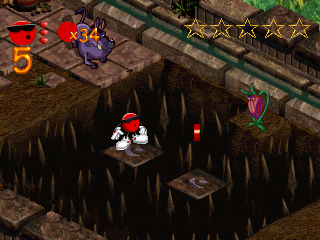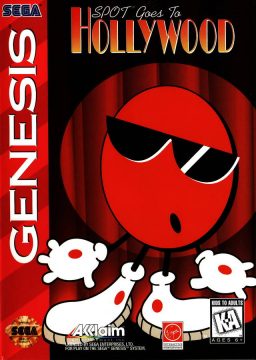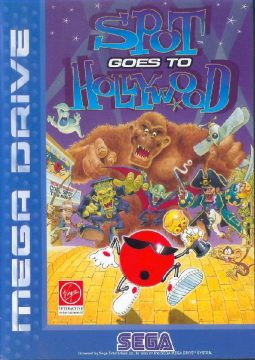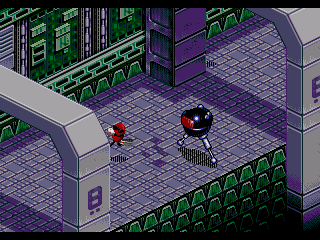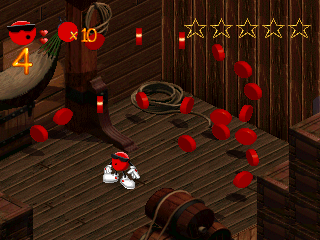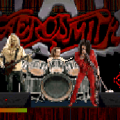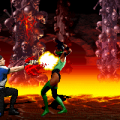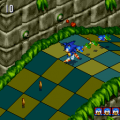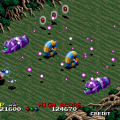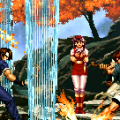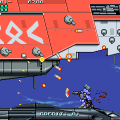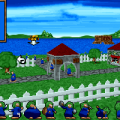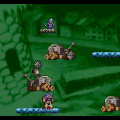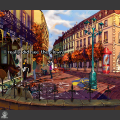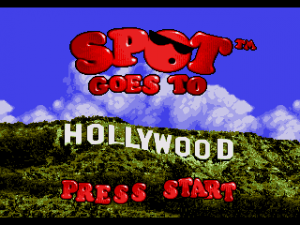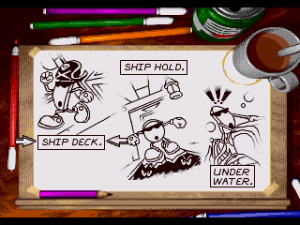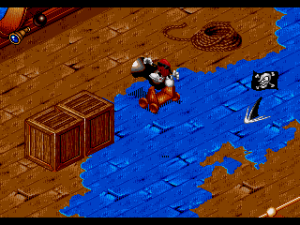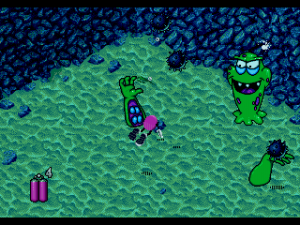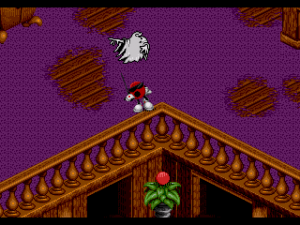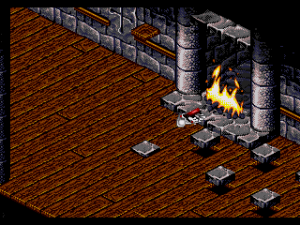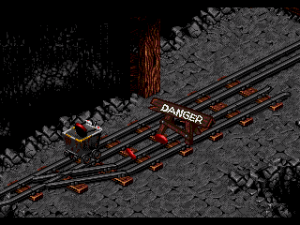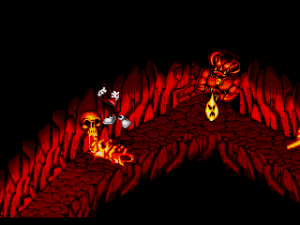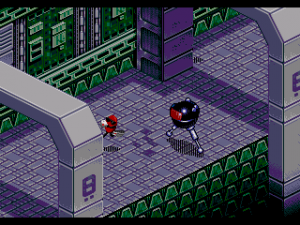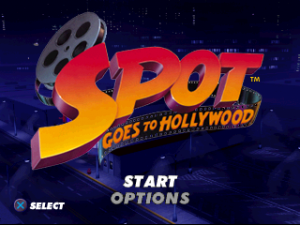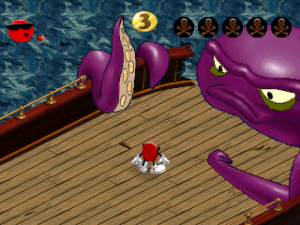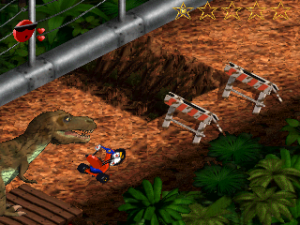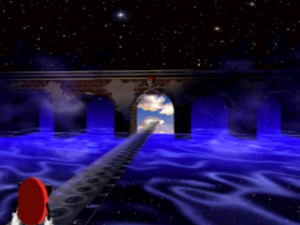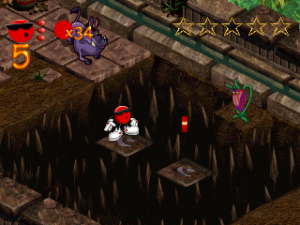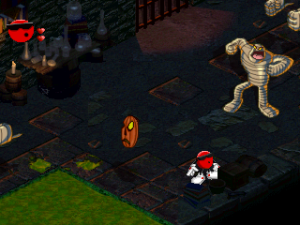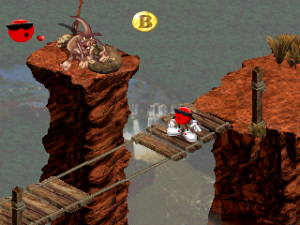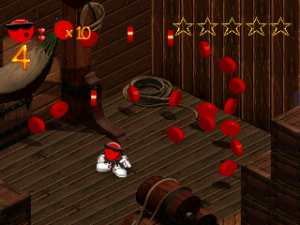- Spot: The Video Game
- Spot: The Cool Adventure
- Cool Spot
- Spot Goes to Hollywood
Apparently there was enough demand for a sequel to Cool Spot that a sequel would end up being made. What’s odd about this particular title is that the only mention of 7-Up is on the copyright screen, where it never appears again. Given how much of an appearance it made in Cool Spot, this is kind of unusual. Maybe the developers were trying to break Spot out on his own? Maybe they didn’t want to bother removing the 7-Up graphics from the PAL version again? It’s a mystery that will probably never be answered. The game also refers to itself as “Cool Spot 3” in the credits, so what was the original? The board game, or the Game Boy game?
There’s still not much of a plot, although there’s still more of one than what Cool Spot gave us. Spot somehow ends up in a bunch of different movie genres, and now he has to fight his way out. It’s not clear is if he’s trapped inside the movies in a Comix Zone situation, or if he’s filming a movie. Since the game has no real story scenes of any sort, we’re left to wonder. The game itself is divided into four worlds, each one with three or four levels each. Once you beat all four worlds, you’ll go to one final stage, set in what is absolutely not the ship from Alien, no sir. Each world is supposedly a different genre of movie, so you’ll go from Pirate World, to Adventure World, and so on. It’s kind of a weird change of pace to have Spot going from fighting crabs and mice to Xenomorphs, though.
The game itself controls and plays a lot like Cool Spot. You’re told to get a certain percentage of cool points, and then to find the exit. The cool spots aren’t quite as numerous as they were in Cool Spot, so you’ll usually only be asked to find ten or twenty of them, instead of fifty or more. The problem is that the cool points tend to be harder to find this time around, so it all amounts to the same amount of wandering. Spot controls more or less exactly the same, as well, and he still fires the same energy/ice/whatever shots. What’s nice, however, is that he no longer takes about five whole seconds to start moving at a decent speed. In fact, there’s actually a run button now, which you’ll want to use for all the backtracking the game’s going to make you do. Spot can take still take quite a few hits, but the health pickups are way too rare, and they barely heal back any damage.
Given the new perspective, this makes combat a huge pain. Just like Cool Spot, enemies take entirely too many hits to kill, and a lot of them will only take damage if you fire at them on the side they’re firing back at you from. The perspective makes it where you’re aiming isn’t entirely clear, either, so your shots might end up missing the enemy entirely. At least most of the enemies in Cool Spot were nice enough to stay still. Here, they’ll either move around so much you can barely hit them, or start chasing you around so much you’ll barely even get a chance to hit them. You can’t even just try to run past the enemies, either, because some of them might be holding the cool points you need to actually progress. It just makes it feel like every enemy you come across is some kind of roadblock that brings the game to a screeching halt, all the while draining your steadily plummeting health.
The perspective can make the platforming a pain at times, too, especially when you figure bottomless pits into things. To be fair, you deal with this sort of thing for just about any game with an isometric perspective. That doesn’t really excuse it here, though, because there’ll be a lot of times when you’ll jump to a platform you’ll think you can reach, only to end up missing it entirely. This isn’t so bad starting off, since that just means you’ll have to get back to where you were, but when you start dealing with levels that are full of pits, it starts to get especially annoying. There’s also a lot of hazards that you probably won’t end up seeing until you walk right over them, like spikes or pools of slime. Given that it takes about four health pickups to heal the damage from one hit, you can see how this can add up. While the game no longer has any continues, it does use passwords, which means that if you end up losing too many lives to cheap hits, you can just start right over from the level you died on.
The level design still isn’t great, although it’s been improved from Cool Spot. A lot of levels have more than a few big, wide open spaces, along with corridors that don’t actually have anything in them. Sure, there’ll be a few items for enemies in them, but it still makes the levels feel more empty than they should be. The levels are generally a little bigger than Cool Spot, partly since there’s doors Spot can go through that lead to new areas. There’s actually quite a few secret areas, too, which helps give you a reason to explore. There’s not much in these besides some point items and maybe a cool point or two, but they’re worth seeking out. There’s even a few minor puzzles involved, like one where you’ll have to jump on stone switches in the right order to put out a fireplace. Nothing that would challenge the sort of people who actually play these games, but it’s still nice.
Not all the levels just involve wandering around a level and collecting stuff, either. Some levels will put you on some sort of vehicle and tell you to just survive to the exit. One of these puts Spot in a minecart, which while cliche, took so long to actually happen in this series it’s actually somehow almost new. All of these levels tend to be a real pain to clear, mostly because so much comes up a little too quickly for you to actually move around it. Each of the last stages of each world also have a boss fight, which is also something that’s somehow never been in this series. None of these are that complex, and all only get about one attack each, but their projectiles come at you so quickly that you can lose lives if you’re not careful.
The game itself looks pretty good, and the game’s been massively stepped up in graphical variety since Cool Spot. Every level actually looks completely unique, although every world shares the same enemies. Spot himself animates as smoothly as he did in Cool Spot, with a heavily shaded style to him. The enemies, on the other hand, are toon-styled drawings. It honestly makes the game look a little inconsistent, given how wildly different two sprites from the same game can look. The music, sadly, isn’t quite as good as the music from Cool Spot, and there aren’t any tracks that can quite match up to the awesomeness of the bonus stage from Cool Spot.
Overall, Spot Goes to Hollywood does a few things better than Cool Spot, but a few things worse. It’s definitely a much less boring game than Cool Spot, considering it doesn’t make you basically repeat the entire game halfway through. The isometric shift and fighting off enemies make it feel so much more frustrating, though, that the improvement might not be worth it for the frustration the game will likely give you. If you don’t like this version, though, there’s always hope.
Spot Goes to Hollywood – Sony Playstation, Sega Saturn (1995)
Only a year after the Genesis version, Virgin would go on to release another version of Spot Goes To Hollywood, this time for the new 32-bit systems. Somehow, surprisingly, the 32-bit version is probably the best out of all the Spot games out there. It’s nothing groundbreaking, but it’s actually a genuinely fun game, even when you look past the license. In a cruel twist of fate, however, it would be the final game in the series. What’s also interesting about this game is that it was made by Burst, a division of Virgin Interactive that would also make the underappreciated adventure game Toonstruck.
The game has the same basic “Spot is in a movie” plot as the Genesis version, although it’s been expanded on. For one thing, there’s actually an FMV cutscene when you boot up the game. For as long as it takes to play out, all that basically happens is that Spot’s in a movie theatre, which is currently playing “Spot Goes to Hollywood”. So, wait, is the movie the game itself, or is it based off the events of the game, or?? Apparently it’s the first one, because Spot ends up falling inside a movie projector and ending up inside the movie itself. Hey, developers! Do you have a mascot, but no way to justify him going through a bunch of unconnected levels? Just have him get trapped inside some piece of media. It worked for Gex, it worked for Comix Zone, and it’ll work for you.
This version still has the Pirate, Horror, and Adventure worlds of the first game, although Sci-Fi’s been cut down to the final stage of the game. Each of the three worlds are made up of about six levels each, and unlike the Genesis version, you have to beat each level in order. You can, however, replay any level you’ve already cleared to look for more secrets. Two of the stages on each world are hidden, and each world ends with a boss stage. There’s also a few bonus stages that go into new genres entirely, like a chase level where Spot has to ride on a tricycle to avoid a T-Rex. Because Jurassic Park was a topical thing at the time, you see.
The game still uses an isometric perspective, just like the Genesis version. Spot also moves, jumps, shoots, and runs the same way. This time around, however, he can only take three hits, with every health pickup you find restoring you to full. What’s new, however, are powerups that Spot can collect and use with the press of a button. These go from things like triple shots and freeze shots, to shields, to bombs that can blow up certain structures. What’s really undergone a major change, though, is the level design. Unlike the Genesis version, where you’d have to wander all over picking up cool points to unlock the exit, you’re free to head straight there whenever you want. All the levels are much more linear, usually going in straight lines with the occasional twist in the path. It’s almost something like an isometric Crash Bandicoot. There’s still cool points to grab, but here they just serve the traditional “grab 100 of these things for an extra life” role.
The fact that the levels are more linear means they’re generally more tightly designed. The fact you aren’t forced to check every single nook on the level for that last damn cool point means that you can actually focus on getting through the level. What’s also nice is that while Spot isn’t as durable as the Genesis version, neither are the enemies. Most of them only take about one hit to kill, or three at the most, as opposed to the ten or so hits it took to kill a single enemy in the Genesis version. This obviously makes the game go by much quicker, and it makes it a lot more fun, too. You don’t even have to kill any of the enemies if they aren’t in your way, since none of them will end up holding the stuff you actually need. On the flipside, there’s generally more hazards to deal with on your way through the level, like balls on chains you’ll have to jump over.
The main collectible of importance this time around are five golden stars hidden around every level. You don’t have to find all of them to beat the game, but if you want the game’s full ending, you’ll need every single one. Some of these are out in the open where you can just grab them, while others will make you solve a small puzzle before you can get them. Other stars are hidden in secret bonus areas, which will usually make you solve some kind of puzzle before they’ll give up the star. These challenges will involve things like picking up cool points in a certain order, navigating a jumping challenge, or using a power-up in a certain way. There’s even a few secret levels you’ll need to open up to get 100%, usually hidden in some obscure way. For example, on one stage, if you see a crate dangling above the floor, you can shoot it down, creating a hole you can leap through to find a new stage. It’s a nice way to add an element of exploration to what are mostly linear levels, and while the ending you get for 100% completion isn’t really worth it, it adds a nice challenge.
Since the game still uses an isometric perspective, there are still times when it can make the game harder than it should be. Some of the jumps you’ll expected to make can be even trickier than the Genesis version. This isn’t so bad when you end up narrowly missing a platform and touching a hazard, because that just means you take some damage. When you’re expected to jump from one tiny platform to another tiny platform, and jumping on a tiny moving platform from there, with one mistake leading to death, that’s a lot harder to forgive. And it’s still entirely possible to end up missing enemies because you’re not standing at just the right angle. It’s not quite as annoying since enemies are so much easier to kill here, but it can still be a pain, at times. You can hold a button to fire in place, but in a game like this, a strafe button would be much more useful.
The levels do a good job of looking visually distinct from one another, and each one generally has some sort of unique feature to it. The highlight would have to be a couple of the “dungeon” stages in the horror world. At first glance, it looks like your average creepy platformer dungeon. Pits of acid, spinning balls on chains, nothing out of the ordinary. Then you notice all the nooses, guillotines, and the ambient background noise of women screaming in pain. A smidge dark for a licensed platformer, really. The creepiness is lessened when you find a zombie tied to a rack, which you can fire at to actually stretch him out. While you can’t stretch him out too far, this being a K&A rated game and all, you can use his stretched body as a trampoline, which is darkly hilarious.
The graphics are fairly decent, although much like the Genesis version, the sprites are still a little inconsistent. The game uses entirely different enemies, but they’re still drawn in the same toony style. Spot’s drawn and animated in the same heavily shaded style he sported in Cool Spot. It’s not that they look terrible, it’s just that compared to Spot, they still just don’t look like they match up. The levels themselves have a pre-rendered look to them, which while it hasn’t aged perfectly well, still looks decent enough for the time period. Some of the music’s reused from the Genesis version, although it uses Redbook audio to give it a more orchestral sound. It sounds all right, but none of it is still particularly memorable.
Overall, Spot Goes to Hollywood is probably a game most people will skip over without a second look. It doesn’t really do anything new or extremely interesting, and it can be unfairly hard at times. It’s a competent platformer if you can look past its issues, so if you’ve exhausted every Crash, Spyro, and Klonoa game and you still want more, it could be worth looking into. The PS1 and Saturn versions of the game are virtually identical, so go with either version you fancy.
